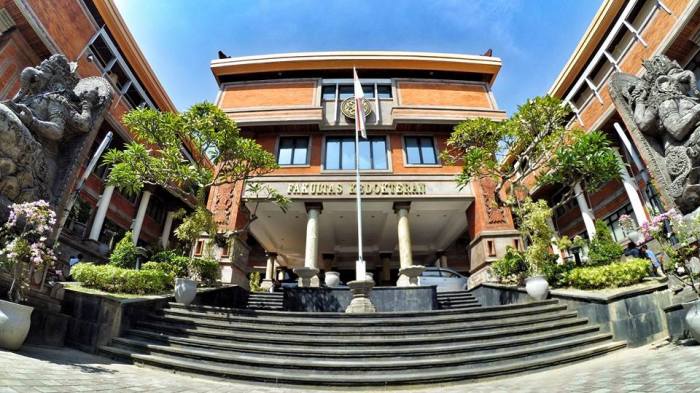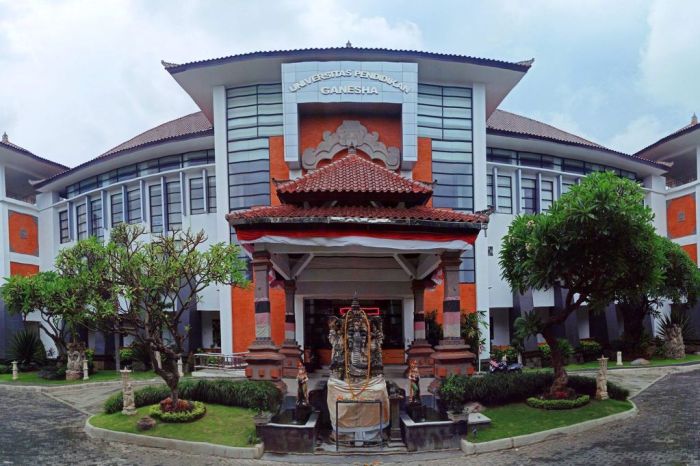Universitas yang bisa kuliah sambil kerja di Bali menawarkan solusi bagi mereka yang ingin mengejar pendidikan tinggi tanpa mengorbankan karier. Mencari keseimbangan antara pekerjaan dan studi memang menantang, namun kemudahan akses pendidikan tinggi di Pulau Dewata memberikan peluang emas bagi individu yang ambisius. Berbagai program fleksibel, mulai dari pembelajaran daring hingga sistem blended learning, memberikan fleksibilitas waktu yang dibutuhkan. Pilihan program studi pun beragam, menyesuaikan dengan kebutuhan dan minat, sehingga menempuh pendidikan tinggi di Bali menjadi lebih mudah dan terjangkau. Inilah panduan lengkap untuk menemukan universitas yang tepat bagi Anda.
Kehidupan modern menuntut keseimbangan. Bagi mereka yang berkarir di Bali dan ingin melanjutkan pendidikan, pilihannya semakin luas. Universitas-universitas di Bali kini banyak yang menyediakan program kuliah fleksibel, dirancang khusus untuk mengakomodasi jadwal kerja yang padat. Sistem pembelajaran daring dan blended learning menjadi solusi praktis, memberikan kemudahan akses belajar kapanpun dan di manapun. Tidak hanya itu, dukungan fasilitas dan bimbingan konseling pun tersedia, menciptakan lingkungan belajar yang suportif. Mari kita telusuri lebih dalam pilihan universitas, program studi, dan biaya kuliah yang sesuai dengan kebutuhan Anda.
Universitas di Bali yang Menawarkan Program Fleksibel: Universitas Yang Bisa Kuliah Sambil Kerja Di Bali

Bali, pulau Dewata yang terkenal akan keindahan alamnya, kini juga menjadi destinasi menarik bagi para pencari ilmu yang ingin kuliah sambil bekerja. Kehidupan yang dinamis di Bali, dipadukan dengan kebutuhan untuk meningkatkan karir, menuntut fleksibilitas dalam sistem pendidikan tinggi. Beruntung, beberapa universitas di Bali telah merespon kebutuhan ini dengan menawarkan program kuliah yang dirancang khusus untuk mengakomodasi mahasiswa yang memiliki kesibukan profesional.
Artikel ini akan memberikan gambaran mengenai universitas-universitas di Bali yang menyediakan program kuliah fleksibel, termasuk sistem pembelajaran, jadwal kuliah, dan dukungan akademik yang ditawarkan. Informasi ini diharapkan dapat membantu calon mahasiswa dalam memilih universitas yang sesuai dengan kebutuhan dan kondisi mereka.
Universitas di Bali dengan Program Kuliah Fleksibel
Beberapa universitas di Bali telah beradaptasi dengan tuntutan zaman dengan menawarkan program-program yang dirancang khusus untuk mahasiswa yang bekerja. Mereka memahami pentingnya memberikan akses pendidikan tinggi yang mudah dijangkau dan disesuaikan dengan gaya hidup yang sibuk. Sistem pembelajaran yang ditawarkan pun beragam, mulai dari kelas tatap muka di malam hari hingga program online sepenuhnya.
- Universitas Udayana (Unud): Unud, sebagai universitas negeri tertua di Bali, secara bertahap mengembangkan program-program fleksibel, termasuk kelas malam dan program studi jarak jauh untuk beberapa jurusan. Informasi lebih detail mengenai program dan jadwal kuliah dapat diperoleh langsung dari situs resmi Unud.
- Universitas Warmadewa (Unwar): Unwar juga menawarkan beberapa program studi dengan jadwal kuliah yang mengakomodasi mahasiswa yang bekerja, baik dalam bentuk kelas malam maupun program blended learning. Mereka seringkali menawarkan sistem pembelajaran yang menggabungkan tatap muka terbatas dengan pembelajaran online.
- Institut Hindu Dharma Negeri (IHDN) Denpasar: IHDN Denpasar, dengan fokus pada studi agama Hindu, mungkin memiliki program yang lebih fleksibel terkait jadwal kuliah dan ujian, namun perlu konfirmasi langsung kepada pihak kampus.
- Universitas Pendidikan Ganesha (Undiksha) Singaraja: Meskipun berlokasi di Singaraja, Undiksha mungkin memiliki beberapa program yang bisa diakses secara online atau dengan jadwal yang fleksibel. Namun, perlu pengecekan lebih lanjut mengenai ketersediaan program tersebut.
Sistem Pembelajaran dan Jadwal Kuliah
Sistem pembelajaran yang diterapkan di universitas-universitas tersebut bervariasi. Beberapa menawarkan kelas malam, yang memungkinkan mahasiswa bekerja di siang hari dan kuliah di malam hari. Yang lainnya mengadopsi sistem blended learning, yang menggabungkan pembelajaran tatap muka dengan pembelajaran online. Beberapa universitas bahkan telah sepenuhnya mengadopsi program online, memberikan fleksibilitas maksimal bagi mahasiswa yang bekerja.
Kebijakan terkait jadwal kuliah dan ujian juga berbeda-beda. Beberapa universitas mungkin memberikan fleksibilitas dalam memilih jadwal kuliah, sementara yang lain memiliki jadwal yang lebih terstruktur. Penting bagi calon mahasiswa untuk menghubungi langsung universitas yang diminati untuk mendapatkan informasi terkini mengenai jadwal kuliah dan ujian.
Dukungan Akademik untuk Mahasiswa yang Bekerja
Memahami tantangan yang dihadapi mahasiswa yang bekerja, beberapa universitas di Bali menyediakan dukungan akademik khusus. Dukungan ini bisa berupa konseling akademik, bimbingan belajar, atau akses ke sumber daya belajar online. Tujuannya adalah untuk memastikan mahasiswa tetap dapat mengikuti perkuliahan dan menyelesaikan studi mereka dengan sukses, meskipun memiliki kesibukan pekerjaan.
Beberapa universitas juga menawarkan sistem pembayaran yang fleksibel, memberikan kemudahan bagi mahasiswa dalam mengatur keuangan mereka. Hal ini menjadi pertimbangan penting bagi mahasiswa yang bekerja dan memiliki keterbatasan finansial.
Mencari universitas di Bali yang mengakomodasi kuliah sambil kerja? Tentu saja ada pilihan! Kehidupan yang seimbang antara karier dan pendidikan tinggi kini semakin mudah diakses, sejalan dengan prinsip-prinsip yang diajarkan dalam semua kitab suci yang Allah turunkan mengajarkan tentang keseimbangan hidup dan pengembangan diri. Dengan fleksibilitas waktu kuliah, Anda bisa meraih impian akademik tanpa mengorbankan stabilitas finansial.
Pilihan universitas yang tepat di Bali akan membuka jalan menuju masa depan yang lebih cerah, sebuah perjalanan yang selaras dengan ajaran kebaikan dan pengembangan potensi diri. Jadi, temukan universitas yang sesuai dengan kebutuhan dan cita-cita Anda di Pulau Dewata.
Tabel Perbandingan Program Studi Fleksibel
| Universitas | Program Studi Fleksibel | Sistem Pembelajaran | Keterangan Tambahan |
|---|---|---|---|
| Universitas Udayana | Manajemen, Akuntansi (Potensial) | Blended Learning, Kelas Malam (Potensial) | Perlu konfirmasi langsung ke universitas |
| Universitas Warmadewa | Pariwisata, Manajemen (Potensial) | Blended Learning, Online (Potensial) | Perlu konfirmasi langsung ke universitas |
| IHDN Denpasar | Studi Agama Hindu (Potensial) | Tatap Muka Fleksibel (Potensial) | Perlu konfirmasi langsung ke universitas |
| Undiksha Singaraja | Pendidikan (Potensial) | Online (Potensial) | Perlu konfirmasi langsung ke universitas |
Catatan: Informasi dalam tabel di atas bersifat umum dan perlu diverifikasi langsung ke masing-masing universitas. Program studi dan sistem pembelajaran yang tersedia dapat berubah sewaktu-waktu.
Persyaratan Pendaftaran dan Biaya Kuliah

Merencanakan kuliah sambil bekerja di Bali? Impian tersebut kini semakin realistis dengan hadirnya beberapa universitas yang menawarkan program fleksibel. Namun, sebelum mendaftar, pemahaman yang komprehensif tentang persyaratan pendaftaran dan biaya kuliah menjadi kunci keberhasilan. Artikel ini akan memberikan gambaran umum persyaratan di beberapa universitas, membandingkan biaya kuliah, dan memberikan panduan praktis dalam menghitung total pengeluaran.
Mencari universitas di Bali yang fleksibel untuk kuliah sambil bekerja? Banyak pilihan tersedia, memudahkan Anda meraih pendidikan tinggi tanpa mengorbankan karir. Kehidupan yang seimbang ini, mengingatkan kita pada pentingnya berbagi, seperti yang dijelaskan dalam artikel ini mengapa beriman kepada malaikat allah dapat mendorong kita gemar bersedekah , sebuah tindakan mulia yang dapat menyeimbangkan aspek spiritual dan material.
Dengan demikian, kesuksesan karier dan kepuasan batin dapat berjalan beriringan, sama seperti kemudahan menemukan universitas yang mendukung gaya hidup kuliah sambil bekerja di Bali.
Persyaratan Pendaftaran di Beberapa Universitas di Bali
Universitas di Bali yang mengakomodasi mahasiswa pekerja umumnya memiliki persyaratan pendaftaran yang relatif sama, namun dengan penekanan pada fleksibilitas jadwal perkuliahan. Dokumen-dokumen seperti ijazah, transkrip nilai, dan kartu identitas tetap menjadi persyaratan dasar. Namun, beberapa universitas mungkin menawarkan proses pendaftaran online yang lebih mudah diakses bagi mereka yang memiliki keterbatasan waktu.
- Universitas A: Umumnya mensyaratkan surat keterangan kerja sebagai bukti kemampuan mengatur waktu kuliah dan pekerjaan.
- Universitas B: Memberikan fleksibilitas dalam memilih jadwal kuliah, dengan opsi kelas malam atau kelas akhir pekan.
- Universitas C: Memungkinkan pengajuan berkas pendaftaran secara bertahap, memberikan kelonggaran bagi mahasiswa yang bekerja.
Perbandingan Biaya Kuliah di Universitas Bali dengan Program Fleksibel
Biaya kuliah di universitas Bali bervariasi, tergantung program studi, jenjang pendidikan, dan fasilitas yang ditawarkan. Program fleksibel umumnya tidak dikenakan biaya tambahan, namun penting untuk menanyakan secara detail kepada pihak universitas terkait. Berikut perkiraan biaya kuliah per semester, yang perlu dikonfirmasi langsung ke universitas masing-masing:
| Universitas | Program Studi (Contoh) | Perkiraan Biaya Kuliah/Semester (Rp) |
|---|---|---|
| Universitas A | Manajemen | 10.000.000 – 15.000.000 |
| Universitas B | Teknik Informatika | 12.000.000 – 18.000.000 |
| Universitas C | Akuntansi | 8.000.000 – 12.000.000 |
Perlu diingat, angka-angka tersebut merupakan perkiraan dan dapat berubah sewaktu-waktu. Selalu cek informasi terbaru di website resmi universitas.
Prosedur Pendaftaran Mahasiswa yang Bekerja
Proses pendaftaran umumnya meliputi pengisian formulir online, pengumpulan berkas, dan pembayaran biaya pendaftaran. Namun, beberapa universitas menawarkan konsultasi khusus bagi mahasiswa pekerja untuk membantu proses pendaftaran yang lebih efisien dan mudah. Keunggulan utama universitas yang ramah pekerja terletak pada fleksibilitas dalam hal jadwal dan metode pembayaran.
- Registrasi online dan pengisian data diri.
- Pengumpulan dan pengiriman berkas persyaratan, termasuk surat keterangan kerja.
- Konfirmasi jadwal kuliah dan pembayaran biaya pendaftaran.
- Pembayaran biaya kuliah dapat dilakukan secara cicilan di beberapa universitas.
Menghitung Total Biaya Kuliah, Termasuk Biaya Tambahan di Universitas A
Sebagai contoh, mari kita hitung total biaya kuliah di Universitas A untuk program Manajemen selama 4 semester. Anggap biaya kuliah per semester Rp 12.000.000, dan biaya tambahan seperti buku, alat tulis, dan transportasi sekitar Rp 2.000.000 per semester.
Total biaya kuliah: Rp 12.000.000/semester x 4 semester = Rp 48.000.000
Mencari universitas di Bali yang fleksibel dengan jadwal kuliah? Banyak pilihan yang mengakomodasi mahasiswa pekerja. Memilih waktu belajar yang tepat, layaknya mematikan televisi jika tidak ditonton merupakan tindakan bijak dalam mengelola sumber daya, juga penting dalam mengatur waktu kuliah. Efisiensi waktu menjadi kunci kesuksesan, sehingga memilih program studi yang tepat dan universitas yang mendukung karier profesional di Bali menjadi krusial.
Dengan perencanaan yang matang, kuliah sambil kerja di Pulau Dewata bukanlah hal yang mustahil.
Total biaya tambahan: Rp 2.000.000/semester x 4 semester = Rp 8.000.000
Total keseluruhan: Rp 48.000.000 + Rp 8.000.000 = Rp 56.000.000
Angka ini merupakan perkiraan dan dapat berbeda tergantung kebutuhan individu.
Tips Mengelola Keuangan Bagi Mahasiswa yang Kuliah Sambil Bekerja
Buatlah anggaran bulanan yang rinci, pisahkan kebutuhan pokok dan keinginan. Prioritaskan pembayaran biaya kuliah dan kebutuhan pokok. Manfaatkan waktu luang untuk mencari penghasilan tambahan, dan jangan ragu untuk meminta bantuan keluarga jika diperlukan. Disiplin dan perencanaan keuangan yang matang adalah kunci kesuksesan.
Program Studi yang Sesuai untuk Mahasiswa Bekerja

Mencari pendidikan tinggi sambil berkarir di Bali? Tantangannya nyata, namun bukannya mustahil. Memilih program studi yang tepat adalah kunci utama. Pertimbangkan faktor fleksibilitas jadwal kuliah, beban studi, dan relevansi dengan dunia kerja. Artikel ini akan mengulas beberapa program studi di universitas Bali yang ideal untuk mahasiswa yang juga bekerja penuh waktu, menggabungkan aspirasi akademik dengan tuntutan profesional.
Program Studi dengan Beban Kuliah Ringan dan Relevansi Kerja Tinggi
Beberapa program studi dirancang dengan mempertimbangkan kebutuhan mahasiswa yang bekerja. Mereka menawarkan fleksibilitas waktu dan kurikulum yang terfokus, sehingga tetap relevan dengan tuntutan pasar kerja. Program-program ini seringkali menekankan pembelajaran berbasis praktik dan proyek, mengurangi beban tugas akademik yang berat.
- Manajemen Bisnis: Program ini menawarkan pemahaman menyeluruh tentang prinsip-prinsip manajemen, pemasaran, keuangan, dan operasional bisnis. Relevansi tinggi di berbagai sektor industri, serta fleksibilitas jadwal kuliah yang seringkali tersedia, membuatnya ideal untuk mahasiswa pekerja.
- Pariwisata: Di Bali, pariwisata merupakan sektor yang vital. Program studi pariwisata menawarkan keahlian dalam manajemen perhotelan, pengelolaan destinasi wisata, dan pemasaran pariwisata. Banyak universitas di Bali menawarkan program ini dengan jadwal kuliah yang mengakomodasi kebutuhan mahasiswa yang bekerja.
- Desain Komunikasi Visual: Program ini cocok untuk individu kreatif yang ingin meningkatkan keterampilan desain mereka. Banyak universitas menawarkan program ini secara online atau dengan jadwal malam, sehingga memungkinkan mahasiswa bekerja untuk mengikuti kelas.
Program Studi yang Dapat Diselesaikan dalam Waktu Singkat
Waktu merupakan komoditas berharga bagi mahasiswa yang bekerja. Memilih program studi yang dapat diselesaikan dalam waktu singkat dapat mempercepat pencapaian tujuan pendidikan. Beberapa universitas menawarkan program akselerasi atau program studi dengan durasi lebih pendek.
- Diploma III (D3): Program D3 umumnya memiliki durasi lebih pendek dibandingkan program S1, menawarkan spesialisasi tertentu dan keahlian praktis yang siap diaplikasikan di dunia kerja. Contohnya, D3 Perhotelan, D3 Manajemen Informatika, atau D3 Akuntansi.
- Program Studi dengan Sistem SKS yang Fleksibel: Beberapa universitas menawarkan sistem SKS (Sistem Kredit Semester) yang fleksibel, memungkinkan mahasiswa untuk mengambil mata kuliah sesuai dengan kemampuan dan ketersediaan waktu. Hal ini memungkinkan mahasiswa untuk menyesuaikan beban studi mereka dengan jadwal kerja.
Ilustrasi Program Studi Fleksibel: Manajemen Digital Marketing
Bayangkan sebuah program studi Manajemen Digital Marketing yang dirancang khusus untuk mahasiswa pekerja. Kurikulumnya menekankan pada praktik langsung, dengan proyek-proyek nyata dan studi kasus dari perusahaan-perusahaan di Bali. Materi kuliah mencakup strategi pemasaran digital, analisis data, pengelolaan media sosial, dan (Search Engine Optimization). Program ini dapat diselesaikan dalam waktu 2 tahun dengan sistem SKS fleksibel dan kelas yang ditawarkan pada malam hari atau akhir pekan.
Contoh Jadwal Kuliah yang Mungkin Ditawarkan:
| Hari | Waktu | Mata Kuliah |
|---|---|---|
| Sabtu | 18.00 – 21.00 | Strategi Pemasaran Digital |
| Minggu | 09.00 – 12.00 | Analisis Data dan |
| Jumat | 19.00 – 21.00 | Pengelolaan Media Sosial |
Dukungan dan Fasilitas untuk Mahasiswa Bekerja
Menyeimbangkan kuliah dan karier merupakan tantangan yang nyata bagi banyak mahasiswa, terutama di destinasi wisata seperti Bali. Namun, sejumlah universitas di pulau Dewata telah menyadari kebutuhan ini dan menyediakan berbagai dukungan untuk membantu mahasiswa pekerja meraih kesuksesan akademik dan profesional. Inilah komitmen nyata dalam menjawab kebutuhan generasi muda yang dinamis dan pragmatis, sebuah langkah progresif yang selaras dengan perkembangan zaman.
Fasilitas dan program yang ditawarkan bervariasi, mulai dari penyesuaian jadwal kuliah hingga layanan konseling yang komprehensif. Pendekatan holistik ini tidak hanya membantu mahasiswa menyelesaikan studi, tetapi juga membangun ketahanan mental dan kompetensi yang dibutuhkan di dunia kerja yang kompetitif. Inilah gambaran lengkap dukungan yang diberikan untuk mahasiswa pekerja di Bali.
Fasilitas Pendukung Kuliah Mahasiswa Bekerja, Universitas yang bisa kuliah sambil kerja di bali
Universitas di Bali terus berinovasi dalam menyediakan fasilitas yang mengakomodasi kebutuhan mahasiswa pekerja. Keberadaan fasilitas ini menjadi faktor penentu keberhasilan mahasiswa dalam menjalani perjalanan akademiknya sambil tetap produktif di dunia kerja. Berikut beberapa contoh fasilitas yang umum ditemukan:
- Jadwal Kuliah Fleksibel: Beberapa universitas menawarkan pilihan kelas malam, kelas akhir pekan, atau sistem pembelajaran jarak jauh (online) untuk memberikan fleksibilitas bagi mahasiswa yang bekerja.
- Layanan Perpustakaan Online 24/7: Akses tanpa batas ke jurnal, buku elektronik, dan berbagai sumber daya digital lainnya menjadi kunci dalam menunjang proses belajar. Hal ini sangat penting bagi mahasiswa yang memiliki waktu belajar terbatas.
- Ruang Belajar Khusus: Tersedianya ruang belajar yang nyaman dan dilengkapi fasilitas internet berkecepatan tinggi dapat menjadi tempat alternatif bagi mahasiswa untuk belajar di luar jam kerja.
- Bimbingan Akademik Personal: Adanya dosen wali atau konselor akademik yang siap memberikan arahan dan dukungan secara personal sangat membantu mahasiswa dalam mengatasi kendala akademik.
Program Bimbingan dan Konseling
Dukungan psikososial sama pentingnya dengan dukungan akademik. Beban kuliah dan kerja dapat menimbulkan stres dan mengakibatkan penurunan performa. Oleh karena itu, universitas menawarkan program bimbingan dan konseling untuk membantu mahasiswa pekerja mengelola stres, meningkatkan keseimbangan hidup, dan mencapai tujuan akademik dan karier mereka.
Program ini biasanya meliputi sesi konseling individual, workshop manajemen waktu, dan kelompok pendukung sebaya. Tujuannya adalah untuk membekali mahasiswa dengan keterampilan yang membantu mereka menangani tantangan dan mencapai kesejahteraan holistik.
Layanan Pendukung Lainnya
Selain fasilitas dan program di atas, beberapa universitas juga menyediakan layanan pendukung lainnya, seperti:
- Akses internet gratis di kampus: Memudahkan mahasiswa untuk mengakses sumber daya digital dan menyelesaikan tugas kuliah.
- Bantuan administrasi: Memudahkan proses administrasi kuliah, seperti pengurusan surat keterangan dan transkrip nilai.
- Kerja sama dengan perusahaan: Beberapa universitas menjalin kerja sama dengan perusahaan untuk menyediakan kesempatan magang atau pekerjaan paruh waktu bagi mahasiswa.
Perbandingan Fasilitas Universitas di Bali untuk Mahasiswa Pekerja
Berikut perbandingan umum fasilitas yang ditawarkan beberapa universitas di Bali (data bersifat ilustrasi dan dapat bervariasi):
| Universitas | Jadwal Kuliah Fleksibel | Perpustakaan Online | Bimbingan Konseling |
|---|---|---|---|
| Universitas A | Ya (kelas malam, online) | Ya (24/7) | Ya (individual & kelompok) |
| Universitas B | Ya (kelas akhir pekan) | Ya | Ya (individual) |
| Universitas C | Ya (online) | Ya | Ya (online & tatap muka) |
Tips Menyeimbangkan Kuliah dan Pekerjaan
Menyeimbangkan kuliah dan pekerjaan membutuhkan perencanaan dan disiplin diri yang tinggi. Berikut beberapa tips efektif:
- Buatlah jadwal yang terstruktur: Alokasikan waktu khusus untuk kuliah, pekerjaan, dan istirahat.
- Prioritaskan tugas: Fokus pada tugas-tugas yang paling penting dan mendesak.
- Manfaatkan waktu luang secara efektif: Gunakan waktu perjalanan atau waktu istirahat untuk belajar atau mengerjakan tugas.
- Jangan ragu untuk meminta bantuan: Jika merasa kewalahan, jangan ragu untuk meminta bantuan dari dosen, teman, atau keluarga.
- Jaga kesehatan fisik dan mental: Istirahat yang cukup dan olahraga teratur sangat penting untuk menjaga produktivitas dan keseimbangan hidup.
Terakhir
Menyeimbangkan pekerjaan dan kuliah di Bali kini menjadi lebih mudah. Berbagai universitas telah beradaptasi dengan kebutuhan mahasiswa pekerja, menawarkan program dan fasilitas yang mendukung kesuksesan akademik dan karier. Dengan pilihan program studi yang beragam dan sistem pembelajaran yang fleksibel, cita-cita untuk meraih gelar sarjana tidak lagi menjadi halangan. Keberadaan universitas-universitas yang responsif terhadap kebutuhan masyarakat ini mencerminkan perkembangan pendidikan tinggi di Indonesia yang semakin inklusif dan inovatif. Langkah berani untuk mengejar pendidikan sambil bekerja akan membuahkan hasil yang bermakna, membuka peluang karier yang lebih baik dan masa depan yang lebih cerah.
 TendikPedia Informasi Mengenai Pendidikan yang Akurat dan Terpercaya
TendikPedia Informasi Mengenai Pendidikan yang Akurat dan Terpercaya